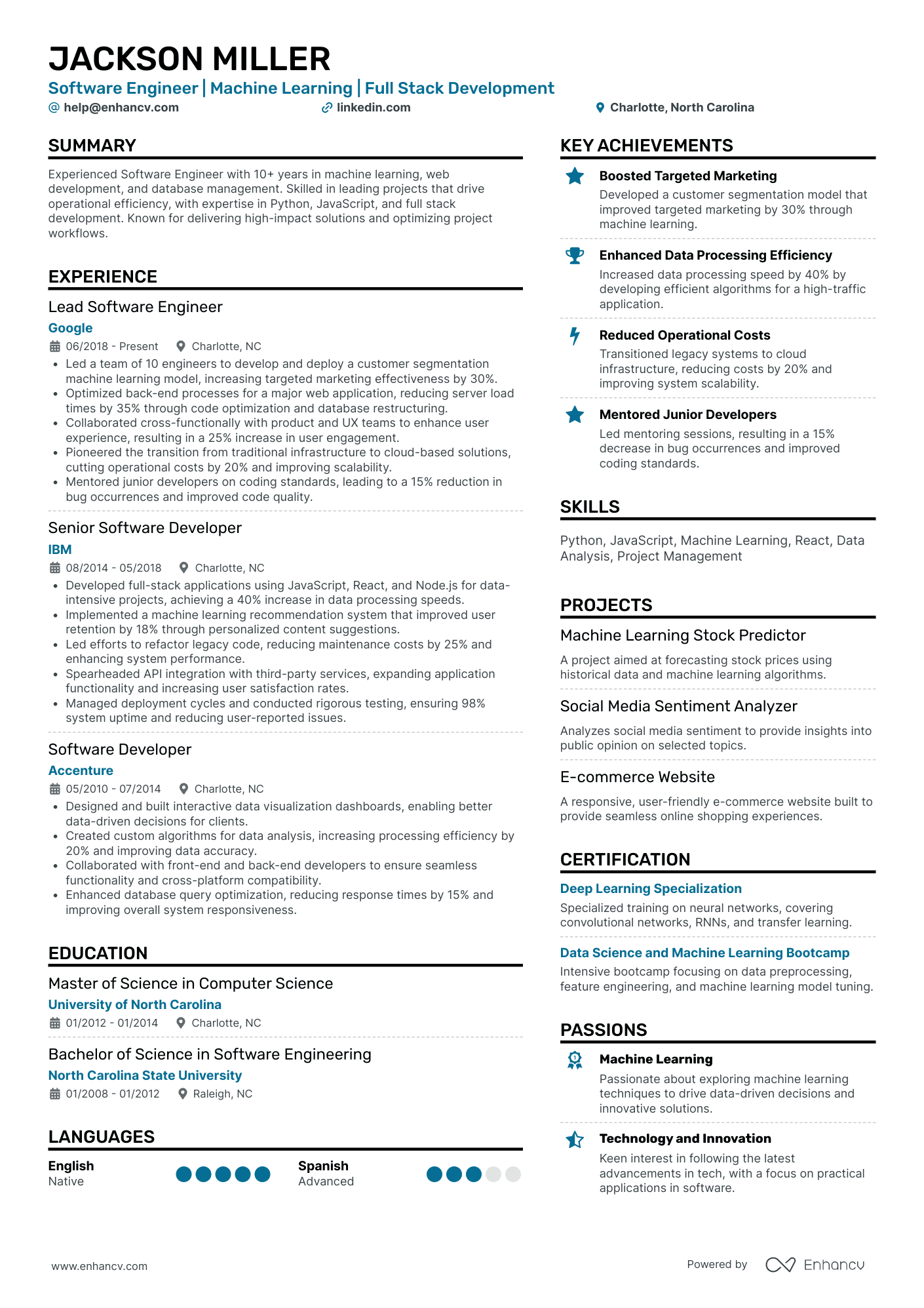Think of your coding projects as a backstage pass for employers, letting them see your skills in action. With the right projects, your resume shifts from a static list to a dynamic display of your technical expertise and creativity, making a lasting impression.
This guide will walk you through the best ways to present coding projects on your resume, so they elevate your profile and catch the eye of tech recruiters.
From choosing the right projects to knowing what details to underscore, we’ll help you make your programming experience an impressive addition to your resume.
What is a programming project?
A programming project is a task or initiative where you apply coding skills to create software, applications, or tools. It typically involves writing code, debugging, and using programming languages to achieve a specific goal.
For Software Development Engineers (SDEs), these projects often include building web applications with front-end and back-end components, developing efficient data structures and algorithms, designing scalable system architectures, and creating automation tools to streamline repetitive tasks.
SDE projects can also involve designing APIs and microservices that enable systems to communicate effectively. Such projects range from simple scripts to complex systems and are excellent for showcasing technical skills, problem-solving abilities, and a solid foundation in software engineering principles.
How coding projects on your resume can help you get a job
Including coding projects on your resume shows employers your real skills in action, making you a stronger candidate. It gives concrete proof of your abilities, sets you apart, and highlights how you tackle real-world problems.
You can use them to show your:
- Creativity: Reflect your knack for creating innovative solutions or unique features, which is valuable in dynamic roles that require fresh ideas.
- Technical knowledge: Prove your expertise with specific languages, frameworks, or tools beyond just listing them, helping employers see your coding skills in action.
- Ability to work independently: Completing development tasks on your own shows employers that you can take initiative and work through tasks without constant guidance.
- Adaptability: They often involve learning new tools, adapting to different programming environments, and finding alternative solutions, showing that you can thrive in changing situations.
- Attention to detail: Successful projects require precision and careful review, which underlines your ability to focus on the fine points, spot errors, and maintain high-quality code.
- Dedication to improvement: Including programming exercises where you expanded your skills or improved your code shows a commitment to learning, growth, and continuous improvement.
Every great project starts with a question and ends with a solution.
Chris Pine, the author of the book "Learn to Program"
How to put coding projects on a resume
Putting your programming projects on a resume is a smart way to prove what you can do. With the right approach, you’ll be able to turn each task into a demonstration of your know-how.
Here are a few useful tips:
Seven useful tips
- Add a section titled “Projects” or “Programming projects” that allows you to showcase relevant work separately from your work experience. This section is especially helpful if your projects are extensive or if you’re early in your career.
- Provide a brief description for each one. Start with the project’s purpose or the problem it addresses, then describe your role. Keep it concise but clear, so recruiters quickly understand the project’s value.
- Write the programming languages, frameworks, and tools you used like Python, JavaScript, React, etc.
- Emphasize the project’s impact by including results or metrics (e.g., “Improved data processing speed by 25%” or “Reduced application load time by 40%”). Quantifiable results show the real-world significance of your work.
- If applicable, link to GitHub repos, live demos, or portfolio sites. This lets recruiters explore your work in more detail and see your coding style firsthand.
- Use bullet points under each project to break down specific achievements, tasks, and skills you demonstrated. It’s more readable and allows HRs to skim for key details.
- Focus on high-quality projects relevant to the job you’re applying for. Select a few that showcase your best work, rather than listing every project you’ve completed.
Listing a mix of project types can draw attention to your versatility and adaptability in different coding environments. Let’s explore the types of coding projects that can strengthen your resume.
Types of coding projects to include
When choosing programming projects for your resume, focus on ones that prove your talent. A blend of personal, collaborative, and professional projects can spotlight your range–from tackling tough challenges solo to thriving in team settings.
Here are some impactful types that are worth featuring:
- Personal projects allow you to explore new languages, frameworks, or concepts. These projects reflect initiative, creativity, and a passion for learning while showing your ability to apply your IT expertise beyond the workplace.
- Contributing to open-source projects demonstrates teamwork, code quality, and familiarity with coding standards, plus, your ability to work with others in a collaborative coding environment.
- Freelance projects prove you can meet professional standards and deliver results under deadlines, emphasizing both technical and time management skills.
- Especially useful for students or recent grads are capstone or class projects because they display skills developed during formal education.
- Hackathons push you to solve problems quickly and work as part of a team under time constraints, making them great examples of problem-solving and teamwork.
PRO TIP
For a cleaner resume, add a link to an online portfolio (GitHub or personal website) where recruiters can explore your projects in more detail.
How to format the project section on a resume
Below, you’ll find a practical example following the guidelines we established above. You can also try the Enhancv resume builder, which lets you include a range of sections, including one for "Projects"!
- •Developed a budgeting tool using Python and Flask that tracks income and expenses, generating monthly reports.
- •Optimized SQL database queries, achieving a 25% reduction in loading time.
Here are some programming project ideas that can make a strong impact on a resume:
20 examples of programing projects to feature
- Personal portfolio website: A website that displays your projects, resume, and coding skills.
- E-commerce store: A fully functional online store with payment processing, product pages, and a user account system.
- Weather app: Pulls real-time weather data from an API and displays it with user-friendly visuals.
- Chat application: A real-time chat app using WebSockets or similar technology to allow multiple users to communicate.
- Data analysis tool: A Python-based project analyzing a dataset (e.g., financial trends or social media metrics) and presenting insights with visualizations.
- Task management app: A to-do list or project management tool with features like task prioritization, deadlines, and collaboration options.
- Recipe finder: Allows users to search for recipes based on ingredients they have, pulling data from a recipe API.
- Machine learning model: A model that performs predictions or classifications, such as predicting house prices or identifying handwritten digits.
- Expense tracker: Lets users track their income and expenses, displaying insights with charts.
- Game: Built from scratch or using a game engine like Unity, which demonstrates logic, animation, and user interaction.
- Social media dashboard: An analytics dashboard that connects to social media APIs to pull and analyze metrics like engagement and follower growth.
- Blog: A content management system that allows users to create, edit, and manage blog posts with tags and categories.
- Image recognition system: An AI model that classifies images, such as identifying animals or objects.
- Inventory management system: To manage stock levels, track orders, and organize products efficiently.
- News aggregator: Pulls news articles from various sources and categorizes them based on user interests.
- Real-time stock tracker: Provides up-to-date stock prices, historical trends, and alerts for preferred stocks.
- Language translation tool: A tool using natural language processing to translate phrases between multiple languages.
- Virtual whiteboard: Lets multiple users draw, write, and edit in real-time, ideal for remote team collaboration.
- Online survey creator: Allows users to create surveys, gather responses, and analyze results.
- Automated web scraper: Collects data from websites for analysis or reporting, such as scraping product prices or job listings.
What skill should you use in your programming projects?
Select skills for your programming projects based on the role you’re targeting. Decide whether you’re interested in front-end, back-end, or full-stack development, as each requires specific skills.
Review job listings to see which skills employers prioritize, and underscore those in your projects. Avoid including too many skills—stick to ones you’re confident in and that complement your experience.
Tailoring your project’s skill set to your desired role makes it more impactful and relevant to recruiters.
Here are some key skills to focus on:
Top skills to highlight in your programming projects
- Problem-solving
- Coding languages
- Debugging and troubleshooting
- Version control
- Code optimization
- Documentation
- Project management
- Database management
- Software testing
- Algorithm design
- Security practices
Frequently asked questions about programming projects
Is it useful to include collaborative projects?
Yes, collaborative projects are valuable as they showcase teamwork, communication skills, and the ability to work in a shared codebase. Underline your specific contributions to the project to make your role clear.
Can I include projects I completed during a coding bootcamp?
Yes, bootcamp projects are valuable and show hands-on learning and practical skills. Highlight any individual contributions, challenges you overcame, and key skills used.
Is it okay to feature projects unrelated to the role I’m applying for?
Generally, it’s best to only include projects that demonstrate relevant skills for the position. However, if the project showcases transferable skills—like problem-solving, teamwork, or a unique technical approach—it may still be worth listing.
In conclusion
To wrap it up, adding programming projects to your resume is one of the best ways to bring your skills to life for recruiters. The right mix of projects can show off your technical know-how, problem-solving skills, and ability to adapt to different challenges.
Make one that's truly you.




